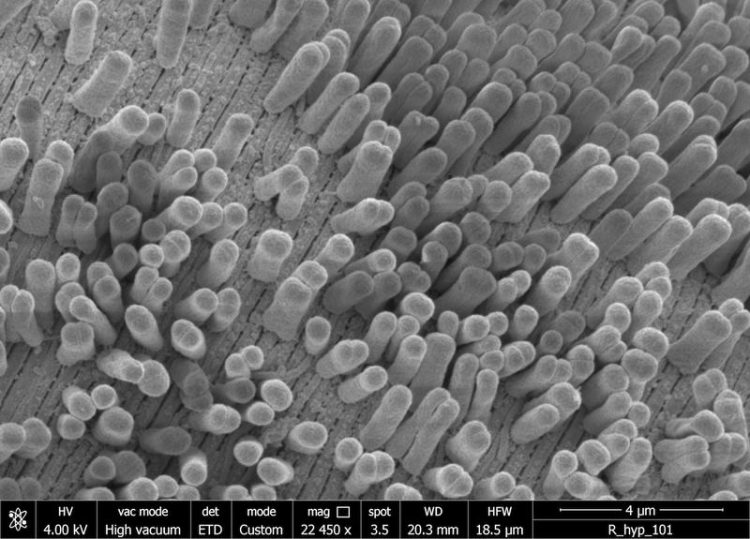Constricting without a string: Bacteria gone to the worms divide differently

The rod-shaped bacteria densely populating the surface of the worm belong to the Gammaproteobacteria. These comprise members of our gut microbiome but also some serious pathogens. Nikolaus Leisch
Even though the diversity and importance of microorganisms in all ecosystems has been established long time ago, our knowledge in many areas of microbiology is still limited. One of those areas is bacterial cell division, detailing how cells reproduce, creating two daughter cells from one. One of the key proteins involved in this process is FtsZ. Like a rubber band, FtsZ creates a ring around the cell and virtually pinches it off, thus initiating cell division. That’s the theory, according to the current state of knowledge. But things can be quite different, as the study on hand shows.
“Nearly all research on this topic was done on a handful of model organisms which can be cultivated in the lab”, explains first author Niko Leisch from the Max Planck Institute for Marine Microbiology in Bremen. As a result, many aspects of microbial life remain undiscovered. Leisch, together with the lead scientist Silvia Bulgheresi from the University of Vienna and Tanneke den Blaauwen from the University of Amsterdam, therefore uses organisms that cannot be cultivated in the laboratory. They study bacteria which live as symbionts on the surface of a small nematode. The worm lives in a symbiosis with only a single species of bacteria, which form a dense but highly organized “coat” on the surface of the worm. That’s why, using these worms, we can study pure cultures from the environment”, Leisch explains the “trick”.
The bacterium in question divides longitudinally, which is already highly unusual for a rod-shaped bacterium. On top of that, the scientists found out that the bacteria divide asymmetrically. The division process starts where the cell touches the worm. The cell pole which is directed towards the environment subsequently follows.
„Microbiology textbooks tell us that bacterial cells assemble a ring of FtsZ before division”, Leisch continues. “Despite using high-resolution microscopic approaches with specific dyes, we couldn’t find this ring.” FtsZ was present, but the proteins only accumulated as small patches along the length axis. “As no ring is formed, these patches of FtsZ must individually exert a force to divide the cell. This has so far not been observed and gives rise to many new questions. For example, how is the necessary force generated to divide the cell?”
Why all of this matters? “The majority of what we know nowadays about bacteria, their growth and reproduction comes from the work from cultivable model organisms”, says Leisch. “But especially the work on bacteria from the environment done in the last few years has shown again and again how the cell division machinery is much more flexible and complex than what we though. And a better understanding of growth and division of bacteria are crucial for the development of potential new antibiotics.”
The scientists suspect that the worm on which the bacteria live influences their cell division. It seems to control its symbiotic residents quite well. For example, it somehow manages to keep its head and tail clear of the otherwise dense coat of bacteria. “We still don’t know how it does that”, says Leisch.
“Resistance to antibiotics is a big issue nowadays. The development of new antibiotics aims towards inhibiting growth and reproduction of bacteria. This worm obviously manages to do just that. If we can understand how it accomplishes that, it would be a great step forward.”
The unusual cell division of this bacterium is probably an adaptation to the symbiotic lifestyle, Leisch and his colleagues suspect. But to better understand the processes and their importance they emphasize that more studies need to be performed on such non-model organisms.
Original publication
Nikolaus Leisch, Nika Pende, Philipp M. Weber, Harald R. Gruber-Vodicka, Jolanda
Verheul, Norbert O. E. Vischer, Sophie S. Abby, Benedikt Geier, Tanneke den Blaauwen and Silvia Bulgheresi: Asynchronous division by non-ring FtsZ in the gammaproteobacterial symbiont of Robbea hypermnestra. Nature Microbiology.
DOI: 10.1038/nmicrobiol.2016.182
Participating institutes
Max Planck Institute for Marine Microbiology, Celsiusstrasse 1, 28359 Bremen, Germany
University of Vienna, Department of Ecogenetics and Systems Biology, Althanstrasse 14, 1090 Vienna, Austria
Bacterial Cell Biology, Swammerdam Institute of Life Sciences, University of Amsterdam, Boelelaan 1108, 1081 HZ Amsterdam, The Netherlands
Please direct your queries to
Dr. Nikolaus Leisch
Phone: +49 421 2028 822
E-Mail: nleisch(at)mpi-bremen.de
or the press office
Dr. Fanni Aspetsberger
Dr. Manfred Schlösser
Phone: +49 421 2028 704
E-Mail: presse(at)mpi-bremen.de
Media Contact
All latest news from the category: Life Sciences and Chemistry
Articles and reports from the Life Sciences and chemistry area deal with applied and basic research into modern biology, chemistry and human medicine.
Valuable information can be found on a range of life sciences fields including bacteriology, biochemistry, bionics, bioinformatics, biophysics, biotechnology, genetics, geobotany, human biology, marine biology, microbiology, molecular biology, cellular biology, zoology, bioinorganic chemistry, microchemistry and environmental chemistry.
Newest articles

First-of-its-kind study uses remote sensing to monitor plastic debris in rivers and lakes
Remote sensing creates a cost-effective solution to monitoring plastic pollution. A first-of-its-kind study from researchers at the University of Minnesota Twin Cities shows how remote sensing can help monitor and…

Laser-based artificial neuron mimics nerve cell functions at lightning speed
With a processing speed a billion times faster than nature, chip-based laser neuron could help advance AI tasks such as pattern recognition and sequence prediction. Researchers have developed a laser-based…

Optimising the processing of plastic waste
Just one look in the yellow bin reveals a colourful jumble of different types of plastic. However, the purer and more uniform plastic waste is, the easier it is to…



